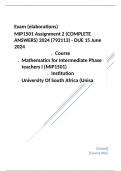Exam (elaborations)
MIP1501 Assignment 2 (COMPLETE
ANSWERS) 2024 (792113) - DUE 15 June
2024
Course
Mathematics for Intermediate Phase
teachers I (MIP1501)
Institution
University Of South Africa (Unisa)
[School]
[Course title]
,Exam (elaborations)
MIP1501 Assignment 2 (COMPLETE ANSWERS) 2024
(792113) - DUE 15 June 2024
Course
Mathematics for Intermediate Phase teachers I (MIP1501)
Institution
University Of South Africa (Unisa)
MIP1501 Assignment 2 (COMPLETE ANSWERS) 2024 (792113) - DUE 15
June 2024 ;100% TRUSTED workings, explanations and soluti ons. for
assistance Whats-App...0.7.4.3.2.7.5.6.4.3...........
Question 1 (24) 1.1. Compare the Egyptian and the Babylonian
numeration systems in terms of the number of symbols, functionality, and
possible uses. (10)
The Egyptian and Babylonian numeration systems have distinct
characteristics and applications:
1. Number of Symbols:
Egyptian Numeration System: This system primarily uses
hieroglyphs and symbols for numbers. It has separate symbols
for powers of ten up to a million, including symbols for 1, 10,
100, 1,000, 10,000, 100,000, and 1,000,000.
Babylonian Numeration System: The Babylonian system is
based on a sexagesimal (base 60) system, using a
combination of symbols to represent numbers. It has symbols
for 1 and 10 but uses a positional system to represent higher
numbers.
2. Functionality:
Egyptian Numeration System: The Egyptian system was
primarily used for record-keeping and calculations related to
trade, construction, and administrative purposes. It was not as
versatile for complex calculations due to its lack of a clear
positional notation.
Babylonian Numeration System: The Babylonian system
was more versatile for calculations due to its positional
, notation, which allowed for the representation of larger
numbers using fewer symbols. This made it suitable for
astronomy, mathematics, and advanced calculations.
3. Possible Uses:
Egyptian Numeration System: The Egyptian system was
suitable for basic arithmetic operations and simple
calculations involving whole numbers. It was commonly used
in daily life for tasks such as measuring land, calculating
taxes, and recording quantities of goods.
Babylonian Numeration System: The Babylonian system's
positional notation made it well-suited for advanced
mathematical calculations, including multiplication, division,
and square root calculations. It was used in astronomy for
tracking celestial events and in commerce for complex trade
calculations.
In summary, while both the Egyptian and Babylonian numeration systems
had their strengths, the Babylonian system was more advanced and
versatile due to its positional notation, making it suitable for a wider range
of mathematical and scientific applications
1.2. Write down three similarities and three differences of the numerations
listed in 1.1. (6)
Certainly! Here are three similarities and three differences between the Egyptian and
Babylonian numeration systems:
Similarities:
1. Symbolic Representation: Both systems use symbols to represent numbers, although
they differ in the number and complexity of symbols used.
2. Historical Significance: Both numeration systems played significant roles in the
historical development of mathematics and commerce in their respective civilizations.
3. Positional Notation Influence: While the Egyptian system lacks a clear positional
notation, it still influenced later numeral systems that incorporated positional notation,
similar to the Babylonian system.
Differences:
1. Base System: The Egyptian system is essentially base 10 (decimal), using symbols
for powers of ten, while the Babylonian system is base 60 (sexagesimal), employing a
combination of symbols with a positional notation.




